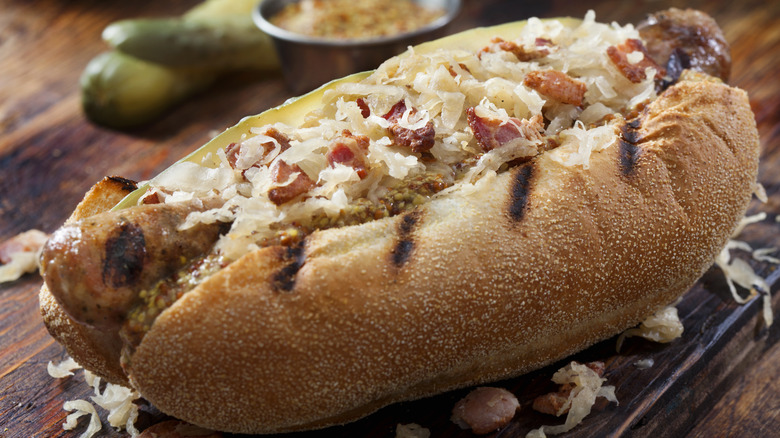Bratwurst Vs Hot Dog: The Flavor Difference Explained
Contrary to popular belief, at least in the U.S., both bratwursts and hot dogs have their roots in Germany. Despite the humble hot dog's association with American cookouts and baseball culture, it is largely believed that the first frankfurter was served up in 1487 in Frankfurt, Germany, while the first record of a bratwurst comes from 1313 in Nuremberg, Germany. Still, beyond the common origins of these sausages, they don't have that much more in common. Whether you're team bratwurst or hot dog, here are the main flavor differences, explained.
A bratwurst is a sausage made up of one type of meat, usually pork, but it can also be beef or veal. Butchers season the meat with a mix of spices like lemon zest, coriander, nutmeg, and caraway seeds, then encase it in a natural sausage casing. A hot dog, on the other hand, is usually made up of a mix of different meats like beef, poultry, and pork, and comes seasoned with more common spices like garlic, coriander, paprika, and allspice. Thanks to unique seasonings, bratwursts usually take on a spicier, more complex taste than hot dogs, which lend a more balanced, general meat flavor since the spices used are more often seen in meat dishes.
The differing textures of these classic German sausages
Bratwurst is a combination of two German words that roughly translates to "waste sausage." While the name might not sound too appealing, it is accurate, as traditional bratwursts come from scraps of meat. That same reality is true for frankfurters, as hot dogs also come from the trimmings of other meats. However, hot dogs are still much more processed than bratwursts. This further explains why a hot dog's flavor is milder than a bratwurst's, as it's made up of the scraps of many different meat blended together.
Beyond the taste of these wursts, they each have equally unique textures too. For example, the meat used to make hot dogs has to be ground into a paste to achieve a uniform taste before being put into its casing. Because it has to be ground much finer, hot dogs aren't as heavy or coarse as bratwursts are. (Although there are a few different varieties of each of these sausages, and their unique textures and flavors will vary depending on the region from where you get them.) And because they're typically highly processed, hot dogs might have more sodium and preservatives, too.
Ways to enjoy your wurst of choice
The versatility of both bratwursts and hot dogs mean that meat lovers can serve their sausages however they please, but there is another important difference: Hot dogs are usually sold pre-cooked, while most commercially sold bratwursts are packaged and sold raw. Nonetheless, both bratwursts and hot dogs can be heated up in a few different ways. Grill them, sear them, boil, or fry them; the choice is up to you. (Just be wary of the temperature mistake that causes them to split.) From there, the sausages are typically served with a variety of toppings. Still, because hot dogs and bratwursts have different tastes and textures, the pairings are usually slightly different.
German Bratwursts are commonly served in a bun with sauerkraut, spicy mustard, and horseradish. Chopped onions and cheese are other popular toppings, and it's not uncommon to serve this wurst served alongside some potato salad or french fries. On the other hand, hot dogs are usually topped with peppers, relish, or chili and are served alongside anything from baked beans to pasta salad. However, the exact toppings and sides depend on the individual. For example, while some condiments seem like a pretty mundane choice, ketchup on hot dogs is basically banned in Chicago. So, traditions aside, it really just depends on personal preference.
No matter your opinion on the ideal sausage, both of these meats are incredibly flavorful and juicy, so it's hard to go wrong. When in doubt, why not throw them both on the grill so you get the best of both wursts?


